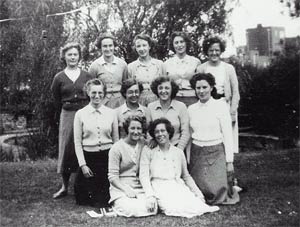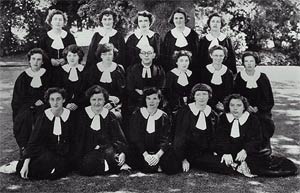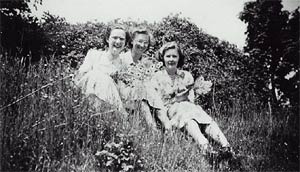|
A West Sussex lady recalls memories of her two year training course at Chichester some 50 years ago. I had always wanted to be a teacher, wrote Mrs June Stone (nee Broadbridge), and on 24th September 1949 I arrived at Bishop Otter College, to begin my training. Miss K. M. E. Murray was the college principal, and the Bishop of Chichester at that time was Rt .Revd. Dr. G. K. A. Bell. With the exception of seventeen students who lived in the Chaplain's Hostel, in The Pallant, students were accommodated in halls of residence in the college grounds. During my first year, my room was in College House, on Fraser corridor, and for my second year I moved to New Hall West. At the end of each corridor there was a mess room where students could do their washing, ironing and simple cooking. At that time, just four years after the end of the war, rationing was still in force and one of our first acts was to hand in our ration books. It was goodbye to my blue under-18 ration book! | 
Trainee teachers at Bishop Otter College, Chichester photographed in June 1950 on a small box camera. These students lived along Fraser corridor and their names are (l to r):- Back row: Patricia Gamble, Joan Murrell, Joan Stiling, Eileen Sills and Josephine Kotch. Middle row: June Broadbridge (now Stone), Patricia Barnard, Iris Archer and Anne Thomas. Front: Pauline Wootton and Mavis Brown
| The college buildings were still drab in places, but work was in progress to repair and redecorate and remove signs of the enforced neglect during the war years. To brighten the college, a painting by Graham Sutherland, Entrance to a Lane, was purchased and other works, including a painting by Ivon Hitchens, and a bronze by Henry Moore were obtained on loan. A group of students took it in turns to provide flower arrangements. A few days after we arrived at college, all the students attended the Annual Service of Thanksgiving and Dedication in Chichester Cathedral. In those days the training course lasted for two years. The college offered courses to prepare students for work with all age groups, from nursery to secondary. I chose to join the group which was training to teach juniors. Each student was required to study two main subjects to a high standard. There were courses in English, mathematics, and Divinity which were taken by all students. Everyone was required to take part in physical education and games courses and in vocational courses covering music and crafts. Much of our time was taken up with work arising from the courses in psychology and in theory and practice of education. The timetable was very overcrowded and writing in the 1950 college magazine, Miss Murray looked forward to the day when the course would be extended to three years. Before going to college, students spent two weeks observing and helping in a school in their home area. Soon after term began the first of many visits to local schools took place. We were divided into small groups and made weekly visits to work with children, using books of our own choice. I went to Westhampnett, where Miss French was head mistress and the children with whom I worked were Sheila Bowsah and Jacqueline Gibson. There were one-day visits to schools in West Sussex and neighbouring counties, some of which were to enable us to observe children in age groups other than the one for which we were training. Special schools were included in these visits. I visited a school for partially sighted children in Clapham and one in Wimbledon for children who were totally blind. During our second term, lessons which we taught in local schools were observed -- and criticised -- by other students in our group. It was surprising how quickly we became used to teaching in front of others. We also taught groups of children who came up to college. Most of this work revolved round the children's room in the huts, and the P.E. apparatus, which in those days was rarely available in junior schools. We did two long teaching practices. For my first practice I taught a large class of eleven year olds at Sussex Road School, Worthing. In the summer vacation we had to do a two week practice at a school in our home area, and a report was submitted by the head teacher. My final teaching practice was at Singleton, where I taught a small class of children aged between nine and eleven. During each of these practices we had to choose a particular child on whom to do a child study. My two main subjects were geography and art. During the art course we made several visits to London galleries and to smaller galleries in provincial towns. As part of the final examination we had to set up a stall to display the work that we had done over the two years. Throughout our course we worked on a special study of an aspect of art which interested us. An additional study was made of the development of art in children. Our teaching practices provided us with children's work to illustrate this. The geography students spent a week at Juniper Hall Field Centre, Dorking, during the summer vacation. Back in Chichester we were out surveying, and in the lecture room, studied our special area, the Americas. For our individual study, we were required to do a geographical survey of our home town. Distinguished speakers visited college for the weekly outside lectures. Some lectures obviously dealt with matters educational, but many were on subjects of rational or world interest. Reading Days occurred three or four times a term. On these days, lectures were cancelled, giving students the opportunity to pursue private study, to have time for wider reading or to visit libraries or museums in connection with their special subjects. Some students found this idea strange at first, but my grammar school had had Free Study Days, when lessons were cancelled to allow for private study, so I was familiar with it. There were college clubs to cater for every interest, from sport to rabbit keeping, from French to rambling. Guide Club gave an opportunity to girls who had been Guides or Rangers, to continue with their activities and help with local groups. I joined the Red Cross. This gave students the chance to mix with young people from the Chichester area, as we were combined with the local detachment which met at The Punch House. Our tutor was Sister Dyson. Bishop Otter was a Church of England training college, so the chapel was a focal point of college life. There were daily morning and evening services, with Holy Communion twice weekly. The chaplain was Rev. Sidney Jellicoe. Visiting preachers often attended services, which were taken not only by Revd. Jellocoe, Miss Murray and other members of the lecturing staff, but by the students themselves. At that time, the needlecraft students were renovating the altar frontals, and the weaving students had undertaken the mammoth task of weaving a new carpet for the chapel aisle. | 
Where are they now? The chapel choir at Bishop Otter College, Chichester photographed by C Howard & Son Ltd, 12 East Gate Square in 1951.They are (l to r):- Back row: Barbara Poile, Eileen Sills, Joan Stiling, Maureen Chatterton and Elizabeth Arnold. Middle: Doreen Chamberlain, Jean Fisher, Iris Archer, Revd Sidney Jellicoe (chaplain), Pauline Orsbourne, June Broadbridge (now Stone) and Elizabeth Easton. Front: Margaret Capell, Jeanette Tweed, Peggy Finch, Margaret Hendin and Patricia Smart.
| I was a member of the chapel choir and in October 1949 and October 1950 in the annual Festival of Parish Choirs - a wonderful experience. In June 1950 we formed part of the choir for the Diocesan Missionary Festival. After a pageant on the lawns of the Bishop's Palace, the Bishop, clergy, choir and actors, walked in procession to Evensong in the Cathedral. My interest in archaeology was awakened when I joined a group working, under the supervision of Miss Murray, at a dig in central Chichester. We dug down to a Roman courtyard, probably dating from the third century, and were thrilled to find pieces of pottery. Miss Murray told us that these were Samian ware and were quite common. We found medieval pottery too, as there were rubbish pits dating from Norman times on the site. I took part in the annual dramatic light evenings, which the students produced. As an art student I was involved in painting scenery for the major productions, 'As you Like It' and 'The Lady's not for Burning'. At Christmas, students went out carol singing to collect for charity. On one occasion the money was used to give a Christmas party to children from St. Paul's Homes, and on another it was donated to a home for the elderly. Snow in mid December 1950 gave Chichester a real Christmassy atmosphere. In college, there was an annual carol service and right at the end of term the candle-lit Christmas supper. These traditional activities made a real impression on one of the lecturers who was on an exchange visit from Wisconsin USA. During our first term at college we were divided into groups, each under the wing of one of the lecturers, for environmental studies. The lecturer in charge of my group knew our allocated area like the back of her hand. She would disappear through apparently impenetrable thickets, or along tiny pathways while we stumbled behind. She would always emerge in a village, or near a tiny church or other point of interest. Such success was not always the case when we students were doing the map reading. I can still hear her voice, as we blundered past what then appeared to be a very overgrown track, saying 'I thought we were going down Binderston Lane'. This term of environmental studies really introduced us to the local countryside and led to our own explorations as time passed. I have many happy memories of trips out to Bosham, Apuldram and Dell Quay; trips to the sea at the Witterings, Selsey and Bracklesham Bay and hours spent exploring Chichester itself. Some of our favourite walks were northwards past Fordwater to East Levant, or on to The Trundle from which there was a wonderful view. We found the tiny church at Sennicotts, and often went out to the Ashlings, or Funtington. We went east to the magnificent Boxgrove Priory - in fact there was hardly a footpath in the area that we did not walk, or a village that we did not explore. The West Sussex Gazette, of which I have been a reader for over forty five years, now keeps one in touch with all of those places. June 30th 1951, was the day on which I left college. It was a day of mixed feelings: anticipation of a teaching career about to begin, thankfulness for the knowledge gained and the fellowship enjoyed, and not a little sadness as that part of my life closed and friends departed for their homes all over the country. I am still in touch with friends from college days, and none of us can believe that our arrival at Bishop Otter was over half a century ago. | 
Gathering wild flowers in a lane near Lavant, June 1951. L to R: DorothyLangford, June Broadbridge and Esmee Chilcott captured on a small box camera.
|
| |


